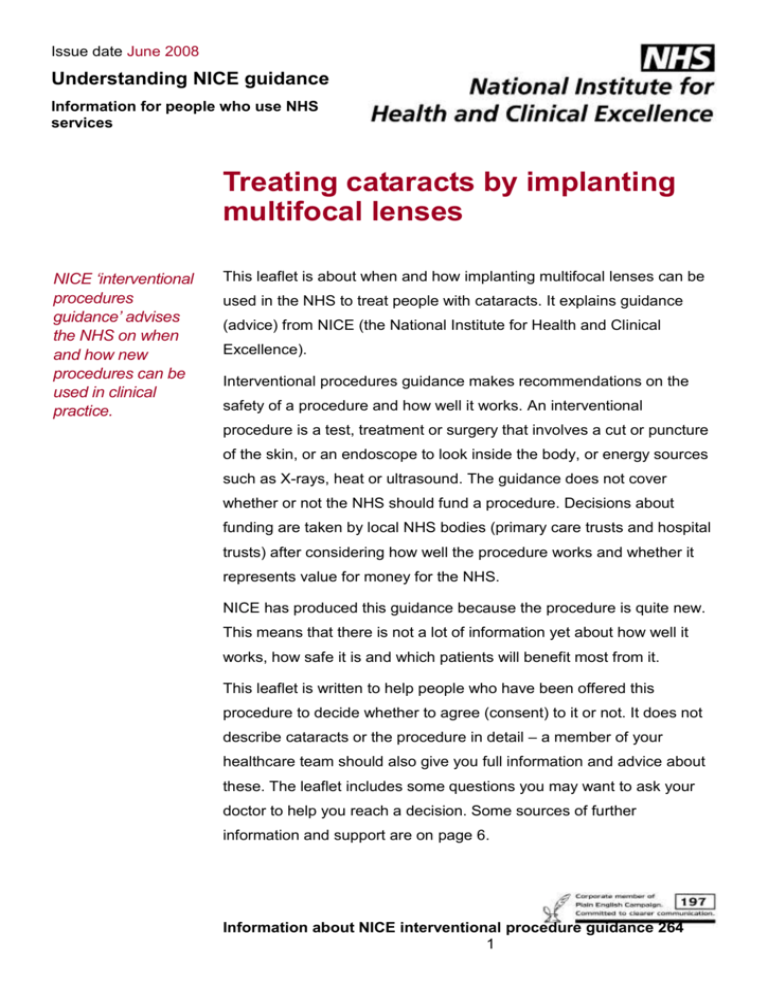
Issue date June 2008
Understanding NICE guidance
Information for people who use NHS
services
Treating cataracts by implanting
multifocal lenses
NICE ‘interventional
procedures
guidance’ advises
the NHS on when
and how new
procedures can be
used in clinical
practice.
This leaflet is about when and how implanting multifocal lenses can be
used in the NHS to treat people with cataracts. It explains guidance
(advice) from NICE (the National Institute for Health and Clinical
Excellence).
Interventional procedures guidance makes recommendations on the
safety of a procedure and how well it works. An interventional
procedure is a test, treatment or surgery that involves a cut or puncture
of the skin, or an endoscope to look inside the body, or energy sources
such as X-rays, heat or ultrasound. The guidance does not cover
whether or not the NHS should fund a procedure. Decisions about
funding are taken by local NHS bodies (primary care trusts and hospital
trusts) after considering how well the procedure works and whether it
represents value for money for the NHS.
NICE has produced this guidance because the procedure is quite new.
This means that there is not a lot of information yet about how well it
works, how safe it is and which patients will benefit most from it.
This leaflet is written to help people who have been offered this
procedure to decide whether to agree (consent) to it or not. It does not
describe cataracts or the procedure in detail – a member of your
healthcare team should also give you full information and advice about
these. The leaflet includes some questions you may want to ask your
doctor to help you reach a decision. Some sources of further
information and support are on page 6.
Information about NICE interventional procedure guidance 264
1
What has NICE said?
This procedure can be offered routinely as a treatment option for
people with cataracts provided that doctors are sure that:
the patient understands what is involved and agrees to the
treatment, and
the results of the procedure are monitored.
However, doctors should make sure that special steps are taken to
explain the potential risks and benefits of the procedure, including
the possibility of seeing halos of light around things at night and
problems with glare at night, and that the lenses may be difficult to
remove or replace. This should happen before the patient agrees
(or doesn’t agree) to the procedure. The patient should be given
this leaflet and other written information as part of the discussion.
When deciding if this procedure is suitable for a patient, doctors
should also consider any factors that make spectacles difficult for
the patient to use (for example, a disability), which may make a
multifocal lens beneficial.
This procedure may
not be the only
possible treatment
for cataracts.
Your healthcare
team should talk to
you about whether
it is suitable for you
and about any other
treatment options
available.
Implanting multifocal lenses
The medical name for this procedure is ‘implantation of multifocal
(non-accommodative) intraocular lenses during cataract surgery’.
The procedure is not described in detail here – please talk to your
specialist for a full description.
A cataract is a clouding of the eye’s natural lens. This can lead to
problems with eyesight and may eventually cause blindness.
Information about NICE interventional procedure guidance 264
2
Treatment of cataracts involves surgery to replace the clouded natural
lens with an artificial, monofocal lens (which has just one strength of
focus). With this type of lens the patient normally has good distance
vision but needs to wear reading spectacles for close work.
This procedure involves implanting a type of artificial lens, called
a multifocal intraocular lens, that can allow both near and distant
objects to be focused on, potentially avoiding the need for spectacles.
The surgery is performed in exactly the same way as for normal
cataract surgery.
Information about NICE interventional procedure guidance 264
3
What does this mean for me?
NICE has said that this procedure is safe enough and works well
enough for use in the NHS. If your doctor thinks that multifocal lenses
are a suitable treatment option for you, he or she should fully explain
what is involved in having the procedure and discuss the possible
benefits and risks with you. In particular, you should be told that you
may experience visual disturbances and that the lenses may be
difficult to remove or replace. You should only be asked if you want
to agree to this procedure after this discussion has taken place.
You should be given written information, including this leaflet, and
have the opportunity to discuss it with your doctor before making
your decision.
You may want to ask the questions below
What does the procedure involve?
What are the benefits I might get?
How good are my chances of getting those benefits? Could
having the procedure make me feel worse?
Are there alternative procedures?
What are the risks of the procedure?
Are the risks minor or serious? How likely are they to happen?
What care will I need after the operation?
What happens if something goes wrong?
What may happen if I don’t have the procedure?
Information about NICE interventional procedure guidance 264
4
You might decide to
have this procedure,
to have a different
procedure, or not to
have a procedure
at all.
Summary of possible benefits and risks
Some of the benefits and risks seen in the studies considered by NICE
are briefly described below. NICE looked at a total of eight studies on
this procedure.
How well does the procedure work?
A review of 10 studies showed that patients who had a multifocal lens
implanted had less need to wear spectacles after the procedure
compared with those who had a monofocal lens: 68% of patients
needed spectacles after the multifocal lens was implanted compared
with 95% of patients who were given the monofocal lens. Two of these
studies also reported that more patients were satisfied with their vision
with the multifocal lens compared with those who received the
monofocal lens, although a further two studies reported no difference.
Two other studies also reported that patients given the multifocal
lens had less need to wear spectacles compared with those given
monofocal lenses.
One study reported that patients given the multifocal lens had better
near vision compared with those given monofocal lenses. Another
reported that more patients with the multifocal lens had better near
vision and distance vision than those given the monofocal lens. In
another study, half the patients who had been given a multifocal lens
and who had no other problems with their eyes had good near and
distance vision.
As well as looking at these studies, NICE also asked expert advisers for
their views. These advisers are clinical specialists in this field of
medicine. The advisers said that the success of the procedure could be
assessed by spectacle independence, looking at the quality of patients’
vision without spectacles, the ability to distinguish between light and
dark images and quality of life.
Information about NICE interventional procedure guidance 264
5
Risks and possible problems
In the review of 10 studies, four of the studies also reported a
higher rate of other visual disturbances – halo and glare – with the
multifocal lens.
In a trial of 40 patients the natural capsule of the eye, which contains
the new lens, had become cloudy at 1 year in 25% of patients who had
a multifocal intraocular lenses fitted. In another study, which looked at
72 patients who had had multifocal lenses, 56% of eyes needed laser
treatment because of problems with the capsule.
As well as looking at these studies, NICE also asked expert advisers for
their views. These advisers are clinical specialists in this field of
medicine. The advisers said that possible problems from this procedure
include problems with middle-distance vision and visual disturbances
such as halos, glare and difficulties in dim light. The advisers also said
that future assessment of safety of the procedure should include an
evaluation of visual disturbances and the need for lens replacement.
More information about cataracts
NHS Direct online (www.nhsdirect.nhs.uk) may be a good starting point
for finding out more. Your local Patient Advice and Liaison Service
(PALS) may also be able to give you further advice and support.
Information about NICE interventional procedure guidance 264
6
About NICE
NICE produces guidance (advice) for the NHS about preventing,
diagnosing and treating different medical conditions. The guidance is
written by independent experts including healthcare professionals
and people representing patients and carers. They consider how
well an interventional procedure works and how safe it is, and ask
the opinions of expert advisers. Interventional procedures guidance
applies to the whole of the NHS in England, Wales, Scotland and
Northern Ireland. Staff working in the NHS are expected to follow
this guidance.
To find out more about NICE, its work and how it reaches decisions,
see www.nice.org.uk/aboutguidance
This leaflet is about ‘Implantation of multifocal (non-accommodative)
intraocular lenses during cataract surgery’. This leaflet and the full
guidance aimed at healthcare professionals are also available at
www.nice.org.uk/IPG264
You can order printed copies of this leaflet from NICE publications
(phone 0845 003 7783 or email publications@nice.org.uk and quote
reference N1599).
We encourage voluntary sector organisations, NHS organisations
and clinicians to use text from this booklet in their own information
about this procedure.
National Institute for Health and Clinical Excellence
MidCity Place, 71 High Holborn, London, WC1V 6NA; www.nice.org.uk
ISBN 1-84629-724-9
N1599 1P Jun 08
Information about NICE interventional procedure guidance 264
7
© National Institute for Health and Clinical Excellence, 2008. All rights
reserved. This material may be freely reproduced for educational and not-forprofit purposes. No reproduction by or for commercial organisations, or for
commercial purposes, is allowed without the express written permission of the
Institute.
Information about NICE interventional procedure guidance 264
8






